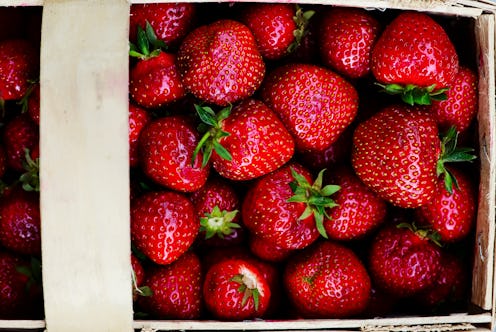Life
This Optical Illusion Is Freaking Us All Out

It's 2017's version of that either black-and-blue or white-and-gold dress none of us could agree on: Red strawberries that aren't even red — because there are no red pixels in the entire photo. Confused? So is everyone else. It's OK. At least we can all suffer through this latest optical illusion together.
Here's the deal: Experimental psychologist Akiyoshi Kitaoka created an image of what looks to be a delicious strawberry creation. I don't know what it is, exactly, but I still want to eat it; the strawberries are plump and juicy and bursting with red color — but hold that thought! The strawberries lie. There are no red pixels in the photo. (Imposters.) And yet somehow, many of us are looking at it and seeing fresh, red strawberries. Just like The Dress before i, the strawberries are starting arguments! They're breaking couples up! They're wreaking general havoc! What are we to do?!
All right, so it's not actually that dramatic of a situation; as far as I know. But it's still weird, right? Is this is another optical illusion? Is this like that one person who painted their legs and some of us thought they were just incredibly shiny? What's the story with these strawberries that look red but really aren't? And seriously, is this some kind of tart or cake? Is the recipe on Pinterest? Me want.
Here's the fruity puzzle in question. Mind? Blown. I want answers.
The mystery that has us seeing red even though we really aren't has a name: color constancy. According to Merriam-Webster, color constancy is the "tendency of the colors perceived as belonging to objects to remain invariable in spite of changes in amount and spectral quality of illumination." In other words, it allows the brain to determine an object's color in the same way despite any changes in the lighting. You could swap out the strawberries for virtually any common object, and the results would likely be the same: A yellow banana, a red stop sign, a bright green lime... You get the ideal.
The details of how color constancy works are largely unknown, but we do at least know that it isn't here to just confuse the heck out of us. It's also a kind of biological mechanism that can help us determine certain things — like whether or not those strawberries are safe and good to eat, regardless of the lighting conditions. Without it, certain things might look unrecognizable under different light. Yes, you already know strawberries are red without needing to see red. That's also part of the equation. But there's another part where our eyes and brain are working together to classify, categorize, and organize different objects.
So, the strawberries are red, you'd know they were red even in the dark, and this is due to color constancy. Case closed!